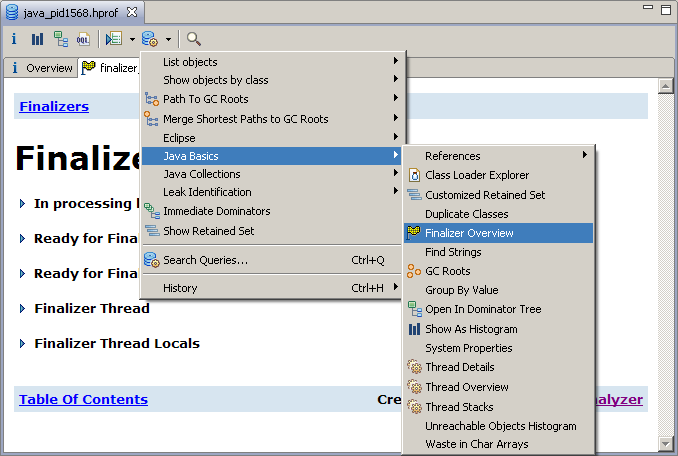Finalizers are executed when the internal garbage collection cleans up the objects. Since you have no control over the finalizer execution, it is recommended not to use them. Because the memory can only be released when the finalize method finished, long running tasks in the finalizer can block the garbage collection. To get the finalizers overview select Finalizer Overview Query from the query list:

This query includes the following subqueries:
| Finalizer in Processing |
Extract the object currently processed by Finalizer Thread. This query returns the currently processed object by the Finalizer Thread if any. The returned object can be processed for one of the following reasons:
Use the finalizer queue query to check the queue. |
| Ready for Finalizer Thread |
This query shows the objects ready for finalization in their processing order. Following reasons can cause a full finalizer queue:
Note:
On J9 JVM-based dumps (e.g. IBM Java, OpenJ9), as expected, this
list shows objects waiting to be finalized. On previous versions
of Memory Analyzer (1.10 and earlier) it also showed those
which have already been finalized and are waiting to be
garbage collected. Those objects where finalization has been
completed are not now shown by this query, but might be in
the unreachable objects histogram if they are waiting to be
reclaimed.
States
Additionally a class-level summary of the objects is provided |
| Finalizer Thread | This query shows the daemon thread which performs the object finalizations. |
| Finalizer Thread Locals |
This query shows the thread locals of the daemon thread that performs the object finalizations. If there are any, this indicates misuse in at least one of the processed finalizers ( finalize() implemented wrong) and might cause severe problems (e.g. unreclaimed memory permanently hold by the finalizer thread or finalizer processed under useless thread locals harming application logic) |
The component report also includes information about objects
belonging to the component which implement the finalize() method
and so could be finalized at some point.